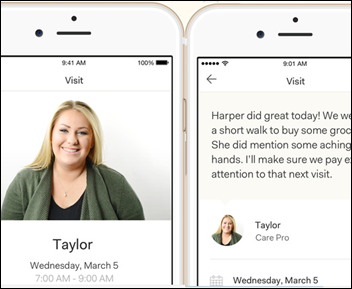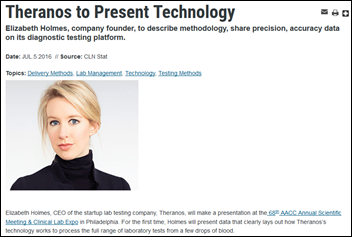News 8/10/16
Top News


Apple CEO Tim Cook speaks about the company’s healthcare aspirations, which he shared while literally leaving the room from a Fast Company interview focusing on whether Apple has stagnated:
We’ve gotten into the health arena. We started looking at wellness. That took us to pulling a string to thinking about research. Pulling that string a little further took us to some patient care stuff. That pulled a string that’s taking us into some other stuff. When you look at most of the solutions — whether it’s devices or things coming up out of big pharma — first and foremost, they are done to get the reimbursement, not thinking about what helps the patient. If you don’t care about reimbursement, which we have the privilege of doing, that may even make the smartphone market look small.
In a possibly related rumor, a Taiwan newspaper says Apple is finalizing suppliers for a new 2017 healthcare product that will capture the heart rate, blood sugar, and other information of users. The newspaper says the product will use new iPhone health sensors as well as Apple’s pressure-sensing technology.
Reader Comments

From Limber Lob: “Re: cost of Epic’s campus. At a User Group Meeting a couple of years ago, Epic founder and CEO Judy Faulkner showed a pie chart of Epic’s costs: 80 percent people, 10 percent buildings, and 10 percent everything else. It would be interesting to see corresponding numbers for other EHR industry players.” Unverified.
From The Stygian Gigawatt: “Re: HIStalk. You run too many unverified rumors.” My position on running reader-provided rumors is thus:
- Rumors are like HIMSS hallway conversations except I’m filtering out some of the blatantly suspicious ones. Readers are free to read them or ignore them.
- Reader-reported rumors are often accurate, even if inexact (a company had layoffs, but in smaller numbers than the rumor suggested).
- Sometimes rumors I run force the hand of companies to publicly admit that they’ve done something they aren’t especially proud of.
- I allow anyone to confirm or deny unverified rumors and will give those responses the same prominence as the original item.
- Readers who don’t like reading rumors are massively outnumbered by those who do, according to responses to my annual reader survey.
- Everybody likes rumors until I run something about their company. That’s when I get indignant emails lecturing me about the sudden need for responsible journalism.
- HIStalk isn’t for everyone and I’m not offended when someone chooses not to read it. There are no teams, corporate overlords, or committees to pretty it up or dumb it down – it’s just me sitting in a spare bedroom. On the other hand, I am happy and frankly shocked that around 50,000 people do read it and I feel a lot of responsibility toward them. My goal from Day 1 (in June 2003) has been to make readers think and rumors help do that.
From The PACS Designer: “Re: ICD-10 decimal places. As we approach the launch of ICD-10 Procedure Codes (ICD-10-PCS) on October 1, thought it would be a good time to discuss some short cuts used previously in ICD-9-CM Clinical Modifications. Removing decimal places should be eliminated for ICD-10-CM as a practice when the Procedure Codes begin being used by institutions. ICD-10-CM uses decimal places and ICD-10-PCS does not use them. Granted, legacy data parameters still need to be mined for the missing decimal place data parameters, but future mining and error reductions should be top priority for everyone to be successful with the new combined coding scheme for both CM and PCS.”
HIStalk Announcements and Requests
I don’t like seeing companies whose entire executive roster is mostly made up of white men. Now I’m questioning another phenomenon I see a lot: American companies whose leadership team is nearly all men of Indian origin. Is that an positive example of diversity or a negative example of the lack of it?
I was having my teeth cleaned today and the hygienist recommend some sort of quick scaling procedure that my basic dental insurance doesn’t cover. She offered to charge me just the discounted price the insurance company would have paid, which I liked, but of course I was wondering as a patient whether I really needed the procedure at all (and all I got for my $144 was a few extra hygienist minutes of scraping around). My post-visit conclusion was that medical and dental practices make a lot of money turning routine maintenance work into an expected healthcare standard and then turning the actual work over to lower-licensed or even unlicensed employees who crank out the billables with no owner involvement. Dermatologists, for example, have figured out that they can make a lot of money selling super-expensive cosmetics, Botox injections, and aesthetic services, all of which require only the dermatologist’s presence, not involvement. American healthcare is bizarre.


We provided two iPads in funding the DonorsChoose grant request of Ms. D in Texas, who says her students have become more engaged and can’t wait to do practice work on the iPads. I’m sorry to report that this is the last set of classroom photos I have since my last round of DonorsChoose funding was back around HIMSS time when I ran out of money, but I have another really large corporate donation that I’m ready to put to work. That will give me more teacher reports and pictures to share.
Webinars
August 10 (Wednesday) 1:30 ET. “Taming the Beast: CDS Knowledge Management.” Sponsored by LogicStream Health. Presenters: Luis Saldana, MD, MBA, CMIO, Texas Health Resources (THR); Maxine Ketcham, clinical decision support analyst, THR; Kanan Garg, senior applications analyst, THR; Patrick Yoder, CEO, LogicStream health. This presentation will review THR’s systematic process for managing clinical decision support assets, including identifying broken alerts, addressing technical and clinical issues, modifying order sets, and retiring tools that have outlived their usefulness. Attendees will learn how THR uses a robust knowledge management platform to better understand how clinicians are interacting with their clinical content to maintain their order sets and reduce the number of alerts fired.
August 24 (Wednesday) 1:00 ET. “Surviving the OCR Cybersecurity & Privacy Pre-Audit: Are You Truly Prepared?” Sponsored by HIStalk. Presenter: John Gomez, CEO, Sensato. Many healthcare organizations are not prepared for an OCR pre-audit of their privacy and security policies. This webinar will provide a roadmap, tools, and tactics that will help balance policies and budgets in adopting an OCR-friendly strategy that will allow passing with flying colors.
Acquisitions, Funding, Business, and Stock
Virtual visit provider Aligned TeleHealth raises $12 million in Series A funding.
Australia-based startup Brontech creates Cyph MD, a blockchain-powered patient information exchange platform that will work across countries.
HealthStream acquires credentialing and privileging solutions vendor Morrissey Associates for $48 million in cash.

Press Ganey Holdings has reached a deal to sell itself to a Sweden-based private equity firm for $2.35 billion. The company’s May 2015 IPO raised $233 million. Shares have risen 27 percent in the past 12 months. CEO Patrick Ryan, who joined the company in 2012, owns shares worth $37 million.

Cerner will add 250 jobs and spend $75 million on facility upgrades at the former Siemens Medical Solutions Health Services offices in Malvern, PA.
Sales

Memorial Hermann Health System (TX) chooses Valence Health to support the Medicaid health plan it is acquiring from Molina Healthcare.
People

Netsmart hires Dawn Iddings (Garmin) as SVP/GM of its home care systems business.
Announcements and Implementations
Stanford Medicine (CA) will develop its clinical genomics service using Google Could Platform for analytics.
EHR/PM solutions vendor WRS Health adds electronic prior authorization functionality from CoverMyMeds to its EHR workflow.
Biometric authentication solutions vendor EyeLock announces an iris recognition technology that works from two feet away, through glasses, and in daylight.
National Institutes of Health will use the clinical genomics solution of Allscripts-owned 2bPrecise as an early adopter, integrating genomic information into its Sunrise EHR.
PatientPing will work on a data-sharing initiative with UMass Memorial Health Care (MA).
Government and Politics
An HHS OIG report finds that Arizona overpaid $14.8 million in Medicaid EHR incentives to hospitals. The state sent $219 million to Medicaid EHR users, of which 70 hospitals were hospitals that received $151 million. OIG suggests that the state repay the federal government, educate hospitals on how to calculate incentive payments, and review the documentation those hospitals to make sure they calculated correctly. Arizona reviewed OIG’s report and disagreed, saying hospitals provided OIG with different cost reporting data than the state used.
The FDA seeks guidance on a new draft report that outlines when medical device vendors must obtain new 510(k) pre-market clearance following a software change. The proposed regulations would require device vendors to submit their product for safety and effectiveness review if the change involves either of those attributes, while those software updates that address cybersecurity only would not require new FDA approval.
Privacy and Security
A hobbyist cybersecurity researcher who has warned several companies about flaws he found in their online security notifies Jefferson Medical Associates (MS) that their patient information is openly visible on the Internet via an unsecured database. The medical group shoots the messenger in having its legal counsel announce that he “accessed the information without our permission,” which of course is the whole point of nicely letting them know. They call his findings “criminal activity” and that he “unlawfully accessed” one of its databases, which is absurd since he didn’t do anything with the unsecured data he found. The practice also haughtily announces that it was already using an outside security contractor who concludes that, “Other than this one place that this individual found to get in, everything is secure.” I guess companies show indignation rather than appreciation since their screw-up requires reporting the incident to OCR and they have to throw someone under the bus to avoid looking stupid to the locals.
Other
Telemedicine remains illegal in technology-obsessed South Korea after legalization efforts fail due to the opposition of medical professionals. Residents also fear that only the wealthy will be able to afford telemedicine, that their data could be exposed in breaches, and that insurance companies might use the information to discriminate against them. The country’s telephone company shut down its e-prescribing program last year after charges that it had sold prescription information to pharmacies. The Korean Medical Association refuses to participate in telemedicine trial projects and in 2014 went on a one-day strike to protest planned introduction of telemedicine and for-profit hospitals.

Bruce Friedman, MD of Lab Soft News questions how conferences handle potential conflicts of interest in their selection of speakers, that discussion triggered by the AACC’s inclusion of Theranos CEO Elizabeth Holmes at its recent conference:
For me, the favoritism that the AACC leadership and planners of the annual meeting have shown toward Holmes is inexplicable. Although the incentive for the Holmes invitation could be attributed solely toward stimulating registration for the annual meeting … it’s possible that some member(s) of the organization may have had some "special" relationship with Theranos or that Theranos provided some financial remuneration to the AACC to pave the way for the Holmes invitation. I have no idea whether this is a the case, but the comments cited above do raise the question of what constitutes conflict-of-interest (COI) for members of professional societies when they participate in the selection of speakers for a conference.
A fascinating New York Times article describes what it’s like to be claustrophobic in the subway- and elevator-filled New York City.
People complain that Epic’s campus is unnecessarily lavish considering it was paid for by non-profit hospitals, so then there’s this: an investigation finds that the VA has 167 interior designers on its staff.
Sponsor Updates

- Aprima customers make over 150 blankets for the Children’s Medical Center in Dallas at its annual users conference.
- GE Healthcare looks at how its Centricity technology is impacting Olympic athletes in Rio.
- Healthgrades releases a new white paper, “How Better Information and Stronger Platforms Build Trust and Improve Healthcare for Consumers and Physicians.”
- The Radicati Group recognizes AirWatch as a leader in its market quadrant for EMM.
- Besler Consulting releases a new podcast, “The challenges of hospital and physician alignment.”
- Boston Software Systems releases a new podcast, “Automating Medicare Patient Account Verification.”
- The Nashville Business Journal names Cumberland Consulting Group to its 2016 Fast 50 honorees.
- The Dallas Business Journal runs “Three Questions with … Michael Nissenbaum, CEO of Aprima Medical Software.”
Blog Posts
- How to Score Points for ACI and MIPS Quality Reporting (AdvancedMD)
- Why do Healthcare Information Systems Account for $40+ Billion? (Catalyze)
- Ensuring Your Patients Have What They Need (CareSync)
- Navigating the Job Market: a Guide for Today’s New Grads (CTG)
- A CIO problem: 50% of doctors don’t know what MACRA is (Advisory Board)
- Nurse Triage Raises the Bar for Centralized Patient Access Centers (Culbert Healthcare Solutions)
- 5 Tips to Managing Your Time Wisely (Direct Consulting Associates)
- CCD vs HL7, which should you choose? (Galen Healthcare Solutions)
- 7 Ways to Plug High-Deductible Health Plan Revenue Leaks (Hayes Management Consulting)
Contacts
Mr. H, Lorre, Jennifer, Dr. Jayne, Lt. Dan.
More news: HIStalk Practice, HIStalk Connect.
Get HIStalk updates. Send news or rumors.
Contact us.
































































































































"most people just go to Epic" that's a problem because then EPIC becomes a monopoly in healthcare, if it isn't…